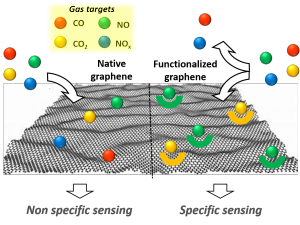Capteurs de gaz à base de graphène fonctionnalisé
Started :October, 2021
Advisors: Benjamin CARBONNIER (ICMPE), Fatima BOUANIS (COSYS-LISIS), Samia MAHOUCHE-CHERGUI (ICMPE), Daniel GRANDE (ICMPE)
Brief summary of the project
Air quality assessment aiming at achieving air pollution reduction has become of primary importance to address health, safety and environmental issues. The global environmental monitoring market has been reported to grow at an annual rate of 7.5% between 2015 and 2020 and is considered to have reached up to $20.5 billion in 2020. This increase is due to various factors such as population growth, implementation of policies toward water, soil and air pollution reduction as well as improved environmental monitoring.
In this context, the development of a new generation of nano-sensors capable of recognizing gases in a highly sensitive, specific and selective way is highly desired and considered as a high-potential solution for air pollution managment. Recent advances in nanomaterials science have open new avenues toward the design of graphene-and carbon nanotubes-based gas sensors. [1-2]. One of the major drawbacks of these sp2 carbon-inspired sensors is the lack of selectivity vis-à-vis a specific gas; rather, they tend to measure the variation in the overall content of polluting gases which, indeed, remains of great interest.
Various approaches have been investigated to date to improve the selectivity of graphene/carbon nanotubes-based gas sensors involving the chemical modification of the nanostructured materials through the molecular imprinting approach or the immobilization of well-defined and highly selective bioprobes such as DNA. Another promising approach relies on the functionalization of the carbon-based nanomaterials with metal or metal oxide (Pt, Pd, Au, Ti, Sn, Rh, ZnO, SnO2) nanoparticles although the obtained selectivity remains below expectations.[3]
The present project takes place in the framework of a two-laboratory partnership, namely NACRE (LPICM-Ecole Polytechnique) and ICMPE (Eastern-Paris Institute of Chemistry and Materials Science), and focuses on the surface functionalization of graphene with either organic molecules, such as porphyrins, or polymers with the aim to providing high selectivity towards gas molecules (Figure 1). One of the originality of this approach relies in the varied nature of metal ions or particles that can be immobilized either within porphyrin cavity or polymer scaffold and enabling for the cost-effective development of a limit-less range of easy-to-use nano-sensors able to specifically monitor the presence and amount of a given toxic gas molecule.

Figure 1: Schematic illustration of the implemented stategy toward the design of selective graphene-based gas sensors.
The present project takes place in the framework of a two-laboratory partnership, namely NACRE (LPICM-Ecole Polytechnique) and ICMPE (Eastern-Paris Institute of Chemistry and Materials Science), and focuses on the surface functionalization of graphene with either organic molecules, such as porphyrins, or polymers with the aim to providing high selectivity towards gas molecules (Figure 1). One of the originality of this approach relies in the varied nature of metal ions or particles that can be immobilized either within porphyrin cavity or polymer scaffold and enabling for the cost-effective development of a limit-less range of easy-to-use nano-sensors able to specifically monitor the presence and amount of a given toxic gas molecule.
References:
[1] Wang, T., Huang, D., Yang, Z., Xu, S., He, G., Li, X., Hu, N., Yin, G., He, D., Zhang, L., A Review on Graphene-Based Gas/Vapor Sensors with Unique Properties and Potential Applications, Nano-Micro Lett. (2016) 8(2), 95-119.
[2] Sinha, N., Ma, J., Yeow, J.T.W., Carbon Nanotube-Based Sensors, Journal of Nanoscience and Nanotechnology, (2006) 6(3) 573-590.
[3] Chatterjee, S.G., Chatterjee, S., Ray, A.K., Chakraborty, A.K. Graphene–metal oxide nanohybrids for toxic gas sensor: A review, Sensors and Actuators B: Chemical (2015), 221, 1170-1181
